Geol 240: Earthquakes Midterm 2 – Flashcards
Unlock all answers in this set
Unlock answersquestion
seismic waves
answer
-propagation of movement/motion through rock; waves of energy that travel through earth's layers -3km/sec average
question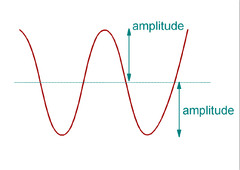
amplitude

answer
-height from crest (or trough) to middle average
question
frequency
answer
-number of waves that pass in a unit of time ie: cycles per second
question
period
answer
-time between wave crests passing a certain point
question
wavelength
answer
-distance from crest to crest (or any relative part of wave)
question
velocity
answer
-tsunami velocity = 800km/hr
question
ocean waves
answer
-driving force:
question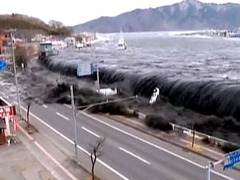
tsunami waves

answer
-high velocity (approx. 800km/hr in open ocean) -low frequency (.6 cycles/minute) -huge wavelength (200km) -generated at shallow (30km depth) part of megathrust fault near oceanic trench (typically 6-10km deep) where there is seafloor uplift (up to 10km)
question
tsunami causes
answer
-oceanic megathrust quakes -deep ocean landslides -large-scale water displacement -seafloor surface rupture is effective at raising seafloor
question
oceanic megathrust faults
answer
-extremely long (1000km) -trench depth 6-10km -10m seafloor uplift in earthquake -slip amount:
question
epicenter
answer
-point at surface above hypocenter
question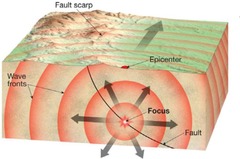
hypocenter

answer
-point in 3D space where fault starts slipping, creating the earthquake -also called focus
question
2011 Tohoku Mw. 9.0
answer
-15,000-25,000 deaths
question
2004 Sumatra Mw. 9.2
answer
-250,000 deaths
question
elasticity
answer
1. distortion (strain) will disappear after applied stress is removed and material will revert to original size and shape (ie: below failure stress, no permanent strain 2. distortion (strain) is proportional to the applied stress (Hooke's Second Law)
question
3 Elastic Moduli
answer
-distortion/strain will disappear after applied stress is removed -material will resort to original size and shape if below failure stress 1. Young's Modulus 2. Bulk Modulus 3. Shear Modulus
question
Hooke's Law
answer
-distortion (strain) is proportional to the applied stress -linear stress to strain relationship
question
Young's Modulus (Y)

answer
-defines relationship of a specific material to an applied stress -Linear Elastic Strain -Hooke's Law -the larger Y is, the less the material will be distorted
question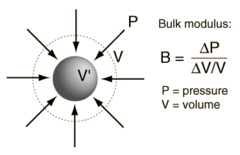
Bulk Modulus (k)

answer
-measure of resistance of material to changes in volume, due to pressure or isotropic stress -also called rigidity or incompressibility -think about a tennis ball vs. shotput and response to isotropic stress
question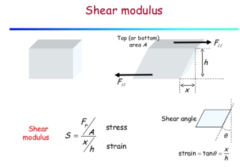
Shear Modulus (M)

answer
-resistance of a material to change in shape -gases and liquids have a M=0, which is why S waves cannot travel through them
question
ray path
answer
-direction of energy travel or wave propagation
question
body waves
answer
-propagate throughout solid earth -include wave fronts and ray paths -includes P and S waves -body waves lose energy faster with distance than surface waves by 1/r2 -body waves are high frequency and lose energy with distance
question
P waves
answer
-"primary" or "pressure" waves -always the first to arrive, fastest moving -parallel to ray path -compressional motion, adding elastic strain to system -don't carry much energy Vp= root (k+4/3M)/density
question
S waves

answer
-"shear" or "secondary" waves -carry most energy in a local earthquake -particle motion perpendicular to ray path -cannot propagate thru gases/liquids because M=0 Sv= vertically polarized S wave Sh= horizontally polarized S wave Vs= root M/density
question
surface waves
answer
-propagate along surface of earth (mostly in crust) -biggest wave phases for distance earthquakes
question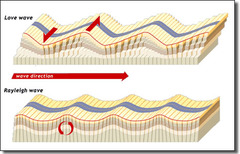
Rayleigh waves

answer
-retrograde ellipse wave pattern
question
Love waves
answer
-horizontally polarized shear waves (Sh) that are trapped in a low velocity layer by total internal reflection (in the crust) -near surface of Earth -what lead to total internal reflection concept
question
geothermal gradient
answer
-1km/30C @ 5km = 120-150C @ 15km = 450C @350-450C, rocks begin to metamorphose and exhibit elastic behavior
question
crustal earthquake depth
answer
-deepest quakes at Wadati-Benioff Zone, 700km
question
polymorphic phase transformations
answer
-400km, corresponding to big wave velocity jump -olive to spinel @650km, spinel to perovskite; another velocity jump
question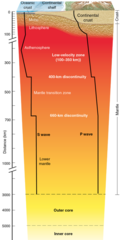
low velocity zone

answer
-LVZ occurs close to the boundary between the lithosphere and the asthenosphere in the upper mantle -characterized by unusually low seismic shear wave velocity compared to the surrounding depth intervals -80-300km depth
question
mantle zones
answer
Crust = 5-80km (rock) Mantle = 2885km (rock) Outer Core = 2270km (metal) Inner Core = 1216km (metal)
question
core formation
answer
-iron core accumulation during accretion/differentiation -core accumulation due to gravity (metal pond theory) -heat LOSS from core drives plate tectonics as a cooling system
question
early Earth heating
answer
1. radioactive decay of metals 2. compression due to gravity (compression = heat) 3. bombardment
question
mechanical layering
answer
-lithosphere vs. asthenosphere -asthenosphere is mechanically weak but NOT MOLTEN
question
compositional layering
answer
-crust vs. mantle vs. core
question
continental crust
answer
-thin, compositionally different -SiO2, feldspars, tectosilicates -buoyant, low density -isostacy -high variable thickness, avg. 30km but ranges 5-85km
question
oceanic crust
answer
-mafic -low Si content -nesosilicates
question
mantle
answer
-largest part of Earth by volume -composed of ultramafic rocks -olivine is dominant in upper mantle -ridge push vs. slab pull vs. basal drag theories
question
teleseisms
answer
-rays from earthquakes a great distance away from seismic station -first arrival ray path for a teleseism is usually coming from straight up underneath a sesimometer
question
first arrival/fastest ray path
answer
-
question
mainshock
answer
-the largest earthquake in a sequence of earthquakes -occurring in same general area
question
foreshock
answer
-smaller quake that occurs before the mainshock -within a brief period of time before the mainshock (not a well defined time period/definition of brief) -approx. same location as mainshock (again not well defined; usually within 1-2 rupture lengths of mainshock) -%5 is CA along San Andreas are foreshocks (5% chance that any small quake will be followed by a larger quake NOT necessarily a big quake)
question
aftershock
answer
-can be thousands after big quake -set of smaller that come after mainshock -in approx same area (1-2 mainshock rupture lengths) -for every mainshock, there will always be about one aftershock that is 1 Mw smaller; 10 that are 2 Mw smaller, 100 that are 3 Mw smaller, etc.
question
Omori's Law
answer
-rate of decay of aftershocks after mainshocks -#aftershocks/day = alpha/time+beta or 1/t -square curve
question
seismometers
answer
1. short-period: measure high frequency short period body waves 2. long period: measure low frequency long period surface waves -vertical, horizontal EW and horizontal NS components
question
earthquake location methods
answer
1. locate surface rupture 2. location of maximum shaking/damage w/ Shake Maps 3. locating with S-P wave travel times
question
S-P travel time curves
answer
-local: # will be small -teleseism: # will be big -for teleseisms, seismic energy usually coming from directly underneath the station, so P waves will be prominently displayed
question
local quakes
answer
-S waves biggest
question
distance quakes
answer
-teleseisms -surface waves will be biggest -body waves lose energy faster with distance than surface waves by 1/r2 -body waves are high frequency and lose energy with distance -LOW FREQUENCY WAVES LOSE ENERGY SLOWER THAN HIGH FREQUENCY WAVES
question
Modified Mercali Intensity Scale
answer
-a "shake map" 1: no movement **** 3: can't feel indoors 5: almost everyone feels it 6: everyone feels it **** 7: difficulty driving 9: really bad damage *** 12: apocalyptic ****
question
Richter Magnitude Scale (Ml)
answer
-theoretically an open scale -1930s CalTech -measures amplitude of seismic waves on a specific type of seismometer -Wood-Anderson Torsion Seismometer -calibrated to 1s period of shear waves at 100km distance -scale ranges from -4 to 10
question
Surface Wave Magnitude Scale (Ms)
answer
-for Ml greater than 7 -based on measurement of 20s or 40s surface waves -otherwise similar to Richter Scale -10x increase in magnitude for every mag. unit -much better at measuring larger or distant quakes
question
Moment Magnitude Scale (Mw)
answer
-energy released in quake -NOT based on measuring amplitude in seismograms -based on measuring entire frequency range of seismic energy released -based on measuring a torque called "Seismic Moment" (Mo) -Mw increases 32x for every unit increase
question
seismic moment
answer
-a torque measured in Mw scale Mo = M * A * D or = to product of shear modulus, area of fault slip, and fault displacement
question
Source Effects
answer
1. Location 2. Duration 3. Magnitude 4. Frequency content of radiated seismic energy -bigger the quake, more low E frequency release -smaller the quake, more high E release 5. Rupture propagation direction and source directivity
question
directivity pulse
answer
-doppler effect on P waves -rupture propagation velocity typically 80-90% of shear wave velocity -need rupture propagation to be parallel to slip direction -almost always happens in large strike slip fault ruptures
question
Path Effects
answer
1. Plate-scale controls 2. Regional subsurface geology
question
Site Effects
answer
1. local geology -bedrock vs. weak soil/sediment basins -sediment vs. bedrock shaking -sediment amplification (Vs30)
question
sedimentary basin effects
answer
-LA basin 10km depth 11x amplitude on sedimentary basin bedrock
question
fault rupture velocity
answer
3km/second



